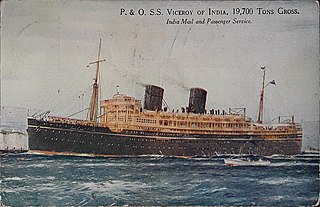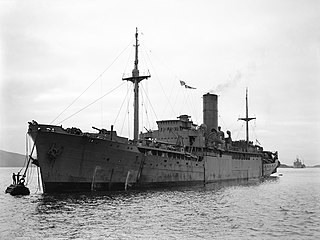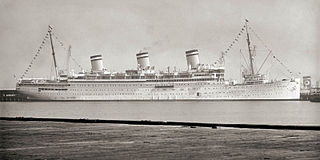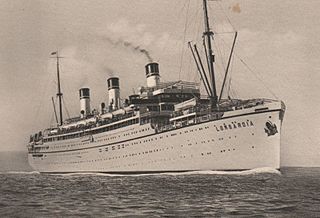
SS Ceramic was an ocean liner built in Belfast for White Star Line in 1912–13 and operated on the Liverpool – Australia route. Ceramic was the largest ship serving the route until P&O introduced RMS Mooltan in 1923.

RMS Viceroy of India was an ocean liner of the Peninsular and Oriental Steam Navigation Company (P&O). She was a British Royal Mail Ship on the Tilbury–Bombay route and was named after the Viceroy of India. In World War II, she was converted to and used as a troopship. She was sunk in the Mediterranean in November 1942 by German submarine U-407.

The Clan Line was a passenger and cargo shipping company that operated in one incarnation or another from the late nineteenth century and into the twentieth century.

SS Clan Chisholm was a British cargo steamship. She was torpedoed and sunk in the Second World War while carrying cargo from India to Scotland.
SS Patroclus was a UK steam turbine passenger and refrigerated cargo liner launched in 1923. She was the third of five ships to bear the name.

HMS Hector was a UK steam turbine passenger and refrigerated cargo liner launched in 1924. She was the fourth of six civilian ships to bear the name.
SS Manistee was an Elders & Fyffes Ltd banana boat that was launched in 1920. She was one of a numerous class of similar banana boats built for Elders & Fyffes in the 1920s.
SS Clan Macneil was a UK steam cargo liner. She was launched in 1921, survived the Second World War and scrapped in 1952. She spent her entire career with Clan Line.

SS Polar Chief was a merchant steamship that was built in England in 1897 and scrapped in Scotland in 1952. In her 55-year career she had previously been called Montcalm, RFA Crenella, Crenella, Rey Alfonso, Anglo-Norse and Empire Chief. Early in the First World War she spent eight months pretending to be the battleship HMS Audacious.
MV El Argentino was a refrigerated cargo motor ship that was built in Scotland in 1920 and sunk by a German aircraft in the Atlantic Ocean in 1943.
SS Clan Macarthur was a British refrigerated cargo steamship. She was built for Cayzer, Irvine and Company's Clan Line Steamers Ltd as one of its Cameron-class steamships. She was launched in Greenock in 1936 and sunk in the Indian Ocean by enemy action in August 1943.
SS Mohamed Ali El-Kebir, formerly SS Teno, was one of a pair of steam turbine ocean liners built in Scotland in 1922 for the Chilean company CSAV. She and her sister ship Aconcagua ran between Valparaíso and New York via the Panama Canal until 1932, when CSAV was hit by the Great Depression and surrendered the two ships to the Scottish shipbuilder Lithgows to clear a debt.

HMS Agamemnon was originally the Blue Funnel Line refrigerated cargo ship Agamemnon. She was built in 1929, traded between the UK and the Far East, and was scrapped in 1963. During the Second World War she was converted into an auxiliary minelayer in 1940, and then into an amenities ship in 1943.

HMS Southern Prince was a motor ship that was built in 1929 as the refrigerated cargo ship Southern Prince. She was commissioned into the Royal Navy in 1940 as a minelayer. She became a headquarters ship and then an accommodation ship in 1944, was a fleet training ship in 1945, and returned to civilian trade in 1946. In 1947 she was sold to Italian owners who had her refitted as a passenger ship and renamed her Anna C. From 1952 she was a cruise ship. She was scrapped in 1972.
SS Juvenal was an oil tanker that was built in Italy in 1928 and registered in Argentina. When built she was the largest ship in the Argentinian registry.

SS Clan Macalister was a Clan Line heavy-lift cargo liner. She was launched in 1930 in Scotland and sunk by enemy aircraft during the Dunkirk evacuation in 1940 with the loss of 18 of her crew. She was the largest ship to take part in the Dunkirk evacuation.
SS Clan Macfadyen was a UK steam cargo liner. She was launched in 1923 and spent her entire career with Clan Line. A U-boat sank her in 1942 with the loss of 82 lives.
SS Santa Fé was a German refrigerated cargo steamship. She is now a Black Sea shipwreck and part of her cargo is of interest to marine archaeologists.

SS Reliance was one of a pair of transatlantic steam ocean liners that were launched in 1914 in Germany for the Hamburg America Line (HAPAG), sold to a Dutch shipping line in 1916, and seized by the United States as World War I reparations in 1922. United American Lines (UAL) operated her until 1926, when HAPAG bought her back.

SS Lombardia was one of a pair of transatlantic steam ocean liners that were launched in 1914 in Germany for the Hamburg America Line (HAPAG), sold to a Dutch shipping line in 1916, and seized by the United States as World War I reparations in 1922. United American Lines (UAL) operated her until 1926, when HAPAG bought her back.











